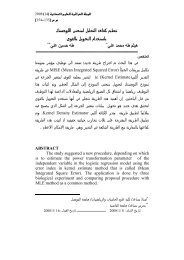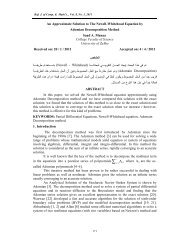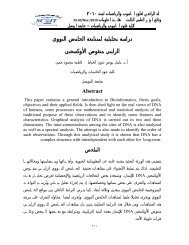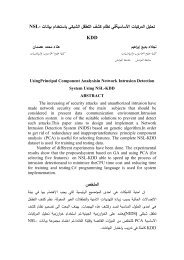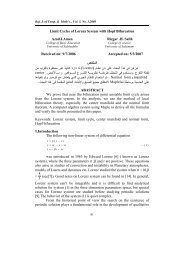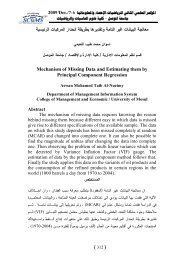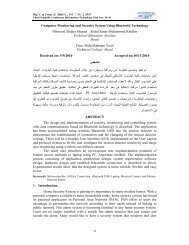Abbas Y. Al-Bayati - Basim A. Hassan - University of Mosul
Abbas Y. Al-Bayati - Basim A. Hassan - University of Mosul
Abbas Y. Al-Bayati - Basim A. Hassan - University of Mosul
- No tags were found...
Create successful ePaper yourself
Turn your PDF publications into a flip-book with our unique Google optimized e-Paper software.
<strong>Abbas</strong> Y. <strong>Al</strong>-<strong>Bayati</strong> - <strong>Basim</strong> A. <strong>Hassan</strong> and Sawsan S. Ismaely i = g i+1 – g iThe vector norms being Euclidian and by searching for the least value <strong>of</strong> f(x)from x i along the direction d i we can obtain the vector x i+1 :xi+ 1= xi+ λidi(5)Where λ is the value <strong>of</strong> λ that minimizes the function <strong>of</strong> one variable.iφ λ)= f(x + λ d )(6)i( i iThis complete the value <strong>of</strong> the iteration, and another one is begun if f(x i+1 ) or g i+1is not sufficiently small, [10].iLet A denote a symmetric and positive definite i×i matrix. For x ∈ R , wedefine:1 TTq ( x)= x A x + b x + c(7)2Let F : RiR denote a strictly monotonic increasing function and define:f ( x)= F(q(x))(8)Such a function is called an extended quadratic function, Spedicato [12].When a minimization algorithm is applied to f, the i th iterate is denoted by x i , thecorresponding function value by f i and its gradient by G i , the function value andgradient value <strong>of</strong> q are denoted by q i & g i , respectively and the derivative <strong>of</strong> F iat q i isdenoted by F ′i . we note that Gi= Fi′giand define ρi= ci/ ci+1for i, where ci = F¢ , <strong>Al</strong>iAssady and <strong>Al</strong>-<strong>Bayati</strong> [4]2. Non-Quadratic Sloboda MethodSloboda [11] proposed a generalized conjugate gradient algorithm forminimizing a strictly convex function <strong>of</strong> the general form:dFf(x) = F(q(x)) ; > 0(9)dqThis algorithm is as follows:• <strong>Al</strong>gorithm 1:*Step 1: Set i = 1 ; d 1 = - G 1 ; G1= g 1.Step 2: Compute λ by ELS & set x =Step 3: Compute gd1= g(x − λ )2i+2i + 1x i+ λ idi.Step 4: Test for convergence, if achieved stop. if not continue.Step 5: If i=0 nod(n) go to Step 1, else continue.T ***Step 6: g = i + 1w g1- g where digiiw = .Ti+d g2*Step 7: Compute the new search direction di+ 1= - gi+1+ βidiwhere:T *yi gi+1*βi= and yTi= gi+ 1− gi.d yiii1i+214



